Five Element Acupuncture Theory and Clinical Applications
TCM Theory
Five Element Acupuncture Theory and Clinical Applications
Five element theory is one of the major systems of thought within Chinese medicine. From a historical perspective it is an important underpinning of medical theory and serves as one of the major diagnostic and treatment protocols. In modern clinical practice the five element theory is used in varying degrees depending on the practitioner and style of acupuncture that they practice.
For practitioners or Traditional Chinese Medicine, the theory may be used to help form a diagnosis when there is conflicting signs and symptoms. Additionally, elements of the theory are useful for assisting patients with nutritional balancing and/or working through emotional issues. The theory is used extensively by Japanese acupuncturists within the five phase treatment protocols and by Classical five element practitioners, such as those who follow the teachings of the late J.R. Worsley. The information below discusses the Five Element theory and clinical applications in detail. For a more general interest description of five elements theory, you may read "A Discussion of Five Element Theory and Applications to Life."
Primary Correspondences Within Five Element Theory
The Five Element theory is based on the observation of the natural cycles and interrelationships in both our environment and within ourselves. The foundation of the theory rests in the correspondences of each element to a variety of phenomena. The most common correspondences are listed in the chart below:
|
FIRE |
EARTH |
METAL |
WATER |
WOOD |
|
| Yin Organs | Heart & Pericardium |
Spleen | Lungs | Kidneys | Liver |
| Yang Organs | Small Intestine & Triple Heater |
Stomach | Large Intestine | Urinary Bladder | Gall Bladder |
| Sense Organs | Tongue | Mouth | Nose | Ears | Eyes |
| Tissues | Vessels | Muscles | Skin | Bone | Tendons |
| Tastes | Bitter | Sweet | Pungent | Salty | Sour |
| Colors | red | yellow | white | blue/black | green |
| Sounds | Laughing | Singing | Crying | Groaning | Shouting |
| Odor | scorched | fragrant | rotten | putrid | rancid |
| Emotions | Joy | Worry/Pensiveness | Grief/Sadness | Fear | Anger |
| Seasons | Summer | Late Summer | Autumn | Winter | Spring |
| Environment | Heat | Dampness | Dryness | Cold | Wind |
| Developmental Stages | Growth | Transformation | Harvest | Storage | Birth |
| Direction | south | center | west | north | east |
| Body Types | pointed features small hands quick energetic |
large features strong legs calm generous |
triangular features strong voice meticulous, strong willed |
round features strong digestion loyal, enjoy movement |
tall slender strong bones and joints hard workers |
Five Element Cyles, Relationships and Interactions
Within five element theory there are four main relationships or ways in which the elements interact. The first of these is the generating (sheng, mother-child) cycle. This cycle describes the ways in which each element, serving as a mother, promotes the growth and development of the following child element.
Examples of this cycle are the Wood element providing the generative force for Fire, Fire providing the generative force for Earth, etc. This relationship provides the foundation for understanding five element theory and, consequently, where imbalances may arise within the cycle. If Earth, for example, is weakened from a poor diet and overwork you will see that more nourishment is requested from the Fire element to nourish Earth. Additionally, if Earth is weakened the Metal element may also be effected.
From a clinical perspective you may see people develop digestive issues from irregular eating, excessive worry and overwork which leads to a proliferation of dampness which then effects the Metal element. Within this case you may see a combination of bloating, gas and poor energy with the development of Metal (Lung) symptoms such as sinusitis or phlegm-type asthma.

The controlling (ke, grandparent-grandchild) cycle provides for a check and balance system among all of the elements. Within this cycle Earth, for example, provides a control for Water and is controlled by Wood. An example of this relationship within the body is in cases of anxiety (Fire) which are related to LV Qi Stagnation (Wood) where, over time, you begin to see more Kidney (Water) related signs as the Water element attempts to control the overactive Fire.

The overacting cycle (cheng) is an imbalance within the controlling cycle where the grandmother element provides too much control over the grandchild and weakens the element. Within nature you may see Water putting out Fire, Earth soaking up Water and so on.
A clinical example of this relationship would be Liver (Wood) overacting on the Spleen (Earth). In this case you have an overactive Wood element overcontrolling Earth leading to distruptions in the digestive system.

The insulting cycle (wu) is also an imbalance within the controlling cycle where the grandchild insults or returns the controlling force generated by the grandmother. Using examples from nature you can see Fire burning up Water and Water washing away Earth and so on.
Clinically you may see this in cases where people have long-term psychological problems (Fire) which eventually effect the Kidneys (Water) as seen in the development of more Yin (Water) deficiency signs.

Five Element Pathology and Clinical Applications
As described in the introduction there are a variety of ways in which the theory is used clinically. Our Japanese section describes the five phase treatments in detail and our classical five element (worsley style) page describes the ways in which a pure five element practitioner would utilize the theory.
This section describes the basic ways in which a practitioner of traditional chinese medicine applies the theory in a clinical setting. The Five Shu (transporting) Points, listed below, represent the relationship of the theory to individual acupuncture points. Our understanding of these points is based largely on the information within the Nan-Ching: The Classic of Difficult Issues.
Five Shu Points
|
Yin Meridians |
Jing-well |
Ying-spring |
Shu-stream |
Jing-river |
He-Sea |
| LU | LU 11 | LU 10 | LU 9 | LU 8 | LU 5 |
| PC | PC 9 | PC 8 | PC 7 | PC 5 | PC 3 |
| HT | HT 9 | HT 8 | HT 7 | HT 4 | HT 3 |
| SP | SP 1 | SP 2 | SP 3 | SP 5 | SP 9 |
| LV | LV 1 | LV 2 | LV 3 | LV 4 | LV 8 |
| KD | KD 1 | KD 2 | KD 3 | KD 7 | KD 10 |
|
Yang Meridians |
Jing-well |
Ying-spring |
Shu-stream |
Jing-river |
He-Sea |
| LI | LI 1 | LI 2 | LI 3 | LI 5 | LI 11 |
| TH | TH 1 | TH 2 | TH 3 | TH 6 | TH 10 |
| SI | SI 1 | SI 2 | SI 3 | SI 5 | SI 8 |
| ST | ST 45 | ST 44 | ST 43 | ST 41 | ST 36 |
| GB | GB 44 | GB 43 | GB 41 | GB 38 | GB 34 |
| UB | UB 67 | UB 66 | UB 65 | UB 60 | UB 40 |
The major point categories (i.e. jing well, etc.) described above are discussed in more detail here. For the purposes of this discussion an extract from the chart above showing only the Mother and Child points provides a good starting point to understand the application of the theory to acupuncture.
The Mother and Child points for each meridian are derived from the chart above using the following logic. According to the generating cycle the mother of Earth is Fire and the child of Earth is Metal. Using this information for the Yin Earth Meridian (Spleen) the mother point is the Fire point on the Spleen meridian SP 2 and the child point is the Metal point on the Spleen meridian SP 5.
Mother & Child Five Element Points
|
Mother |
Child |
|
| Lung (Metal) | LU 9 | LU 5 |
| Large Intestine (Metal) | LI 11 | LI 2 |
| Stomach (Earth) | ST 41 | ST 45 |
| Spleen (Earth) | SP 2 | SP 5 |
| Heart (Fire) | HT 9 | HT 7 |
| Small Intestine (Fire) | SI 3 | SI 8 |
| Urinary Bladder (Water) | UB 67 | UB 65 |
| Kidney (Water) | KD 7 | KD 1 |
| Pericardium (Fire) | PC 9 | PC 7 |
| Triple Heater (Fire) | TH 3 | TH 10 |
| Gall Bladder (Wood) | GB 43 | GB 38 |
| Liver (Wood) | LV 8 | LV 2 |
A clinical example of this theory would be dispersing the child point of the Wood meridian (Liver) - LV 2 - in the case of LV Fire Rising where a patient is experiencing LV signs such as anger and irritability along with HT related signs such as disturbed sleep and agitation.
Another example would be tonifying the mother point of the Earth meridian (Spleen) - SP 2 - in the case of SP Qi Deficiency where a patient is experiencing poor appetite and low energy.
The example above brings up an interesting point from the perspective of a TCM practitioner. While the five element theory is a useful tool in many cases, there are times where the theory indicates a point which clinical experience has proven to be less effective than another point. In the case above, SP 2 is indicated by the theory whereas SP 3 is more commonly used for this condition. Some of the points which have varying degrees of correspondence with the theory are:
- HT 9 & PC 9 - are most often used to clear heat.
- SI 3 & SI 8 - reduce heat, pain and stagnation but provide no tonifying effect.
- LI 11 - is typically dispersed to clear heat.
- TH 3 - has no tonification effects.
- ST 41 - is typically used to disperse fever a/or reduce abdominal distention, although it can be as a local point in a tonifying manner to increase energy flow to the foot.
- SP 2 - is not the most tonifying point on the SP meridian - SP 3 is a better choice.
- UB 67 - dispersive point for acute conditions.
- GB 43 & GB 38 - are both used to clear heat.
For further study from a Japanese perspective you should consult our five phase treatments page. For Worsley style information, see our Classical Five Element (worsley) style section.
All Content 1999-2025
Chad J. Dupuis / Yin Yang House
Our Policies and Privacy Guidelines
Our Affiliated Clinics
